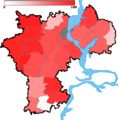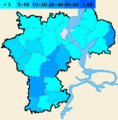Ulyanovsk Oblast
|
Subject of the Russian Federation
Ulyanovsk Oblast
Ульяновская область
|
||||||||||||||||||||||||||||||||||||
Coordinates: 53 ° 43 ' N , 48 ° 2' E
The Ulyanovsk Oblast ( Russian Ульяновская область / Uljanowskaja oblast) is an oblast in Russia . It is located in the Volga Federal District on both sides of by the Kuibyshev reservoir widened Volga . In the north and northwest it borders on Tatarstan , Chuvashia and Mordovia .
The oblast was formed on January 19, 1943 in the Russian SFSR of the Soviet Union from parts of the territory that had previously belonged to the Kuibyshev and Penza oblasts .
history
The region has been inhabited for thousands of years. From the 7th century it was part of the Volga Bulgarians . For centuries, however, they had to pay tribute to the Khazar Empire . It was only after the end of the Khazar Empire in 966 that the Volga Bulgarian Empire became truly independent. From 922, Islam spread among the residents of the region. Later - in 1236 - they became tributaries to the Mongols . When the power of the Mongol rulers decreased, the Kazan Khanate was established in 1437/38 . In 1552, under Tsar Ivan the Terrible , the Russians conquered the Kazan Khanate and it subsequently divided the history of Russia. Gradually the number of Russian settlers increased. In 1648 the city of Sinbirsk (from 1780 Simbirsk, today Ulyanovsk ) was founded. From 1708 to 1780 it was part of the Kazan Governorate . In 1780 the area was separated from Kazan. From 1780 to 1796 it was named Lieutenancy Simbirsk , then until 1924 Simbirsk Governorate . In honor of Lenin , it was named Ulyanovsk Governorate from 1924 to 1928 . On May 14, 1928, this governorate became part of the new Middle Volga Oblast. In the following year, on October 20, 1929, it was renamed the Middle Volga Krai . After renaming to Krai Kuibyshev (1936 Oblast) it belonged to this administrative unit until January 19, 1943. Since then it has been an independent oblast.
population
In the last censuses in 2002 and 2010, there were a population of 1,382,811 and 1,292,799 residents respectively. The number of inhabitants thus fell by 90,012 people (−6.51%) in these eight years. In 2010, 950,630 people lived in cities. This corresponds to 73.53% of the population (in Russia 73.72%). By January 1, 2014, the population continued to decrease to 1,267,561. The distribution of the different ethnic groups was as follows:

| nationality | VZ 1989 | percent | VZ 2002 | percent | VZ 2010 | percent |
|---|---|---|---|---|---|---|
| Russians | 1,016,815 | 72.83 | 1,004,588 | 72.65 | 901.272 | 69.71 |
| Tatars | 159.093 | 11.39 | 168,766 | 12.20 | 149,873 | 11.59 |
| Tschuwaschen | 116,539 | 8.35 | 111,316 | 8.05 | 94,970 | 7.35 |
| Mordwinen | 61,061 | 4.37 | 50,229 | 3.63 | 38,977 | 3.01 |
| Ukrainians | 17,710 | 1.27 | 15,588 | 1.13 | 10,484 | 0.81 |
| Azerbaijanis | 2,805 | 0.20 | 5,006 | 0.36 | 4,649 | 0.36 |
| Armenians | 1,448 | 0.10 | 4,745 | 0.34 | 4,520 | 0.35 |
| Zigane | 1,240 | 0.09 | 2,034 | 0.15 | 3,301 | 0.26 |
| Belarusians | 4,617 | 0.33 | 3,891 | 0.28 | 2,647 | 0.20 |
| German | 1,838 | 0.13 | 2,963 | 0.21 | 1,872 | 0.14 |
| Residents | 1,396,193 | 100.00 | 1,382,811 | 100.00 | 1,292,799 | 100.00 |
Note: the proportions refer to the total number of inhabitants. Including the group of people who did not provide any information about their ethnic affiliation (2002 97 and 2010 67,890 people)
The area's population is over 70% Russian . Other larger ethnic groups are the Tatars , Chuvashes and Mordvins . However, their number is falling, as is that of the Russians. On the other hand, immigration from the North Caucasus, Transcaucasus and Central Asia has taken place since the end of the Second World War. In addition to the nationalities listed above, there are also many Uzbeks (1959: 198; 2010: 1,435 people), Tajiks (1959: 202; 2010: 1,375) and Georgians (1959: 147; 2010: 449).
The Russians make up the majority of the population in 16 of the 21 Rajons (with 56 to 89% share). In Nikolajewski Rajon they are also the strongest ethnic group with 43%. The Starokulatkinski Rajon has the lowest proportion of Russians (only 2%). The Tatars are in the majority (95%) in Starokulatkinsky district; in Novomalyklinsky Rajon they are the strongest ethnic group with 31.6%. The Chuvash are the majority of the population in the Zilninsky Rajon (58%) and form a strong minority group in the Mainski Rajon (25%). The Mordvines are not a majority of the population in any Rajon; in the three districts of Kuzovatovsky (27%), Nikolayevsky (30%) and Novomalyklinski (28%), however, significant minority groups.
Important ethnic groups
economy
The most important branches of industry include mechanical engineering, the light and food industries.
Administrative division and largest places
The Ulyanovsk Oblast is divided into 21 Rajons and 3 urban districts . The most important city next to the administrative center of Ulyanovsk is the city of Dimitrovgrad . All other places in the oblast have fewer than 20,000 inhabitants. There are a total of 6 cities and 29 urban-type settlements in the oblast .
| Surname | Russian | Residents (October 14, 2010) |
|---|---|---|
| Ulyanovsk | Ульяновск | 614.786 |
| Dimitrovgrad | Димитровград | 122,580 |
| Insa | Инза | 18.803 |
| Barysch | Барыш | 17,149 |
| Novoulyanovsk | Новоульяновск | 16,033 |
Web links
Individual evidence
- ↑ Administrativno-territorialʹnoe delenie po subʺektam Rossijskoj Federacii na 1 janvarja 2010 goda (administrative-territorial division according to subjects of the Russian Federation as of January 1, 2010). ( Download from the website of the Federal Service for State Statistics of the Russian Federation)
- ↑ a b Itogi Vserossijskoj perepisi naselenija 2010 goda. Tom 1. Čislennostʹ i razmeščenie naselenija (Results of the All-Russian Census 2010. Volume 1. Number and distribution of the population). Tables 5 , pp. 12-209; 11 , pp. 312–979 (download from the website of the Federal Service for State Statistics of the Russian Federation)
- ↑ Ukas of the Presidium of the Supreme Soviet of the USSR of January 19, 1943 (Russian)








